Our Living, Our Future, Our Truckers
Host: Hodgson River Station
Written by Jo Bloomfield – Manager, Hodgson River Station.
We produce animals with the intention that they are used for food by people who do not have the land, resources, time, or desire to produce their own. We supply on occasion to abattoirs in Australia where our animals are slaughtered and their meat sold to various outlets in Australia and possibly exported. We have sold to open auction markets live animals and we sell to other producers. The majority of our animals are sold to live animal export markets, predominantly Indonesia but also the Philippines, Vietnam and Egypt.
In many ways live export suits our operation due to the type of animal we can economically turn off from the pasture and rainfall we have available and the distance of the market access.
In regards to the recent cruelty expose’s conducted over the last few years, there is no doubt that the slaughter of animals in some overseas abattoirs is poorly conducted. I support the implementation of stunning for all cattle. I support our industry to assist with training and education of what better animal welfare is and put it in practice. All our livestock we have sold into live export markets since the 2011 ban have been stunned prior to slaughter. There are no doubt the live export markets have animal welfare issues to improve, control and correct but the answer isn’t to shut the whole live export industry down. I implore people who support a ban to actually speak to those who it would directly affect because I honestly do not believe that those who support the ban comprehend the ramifications of what a ban on live export impact would be both short and long term.
Some factors affecting our choice of Live export to abattoir supply is as follows.
|
Factor |
Live Export |
Abattoirs |
| Animal Type | Takes younger animal that is not finished in growth = Light
Will take heavies – not mouthed |
Requires animals that are heavy
Requires animals to be mouthed and aged |
| Distance to travel | Darwin 700km
Wyndham 959km |
Townsville 1924km
Adelaide 2641km Melbourne 3297km |
| Animal Welfare |
Short truck trip with break prior to boat that allows feed and water |
Long haul truck trips with break to next leg of long haul |
| Costs |
Transport mainly Animals able to maintain condition |
Transport, rest yard fees, if light need to be fed for period of time to slaughter weights. |
| Animal Breed |
Droughtmasters are acceptable to both operations. |
|
| Market requirements | Will take both unfinished and heavies
Access can be specific to dry season |
Wants all heavies
Often preferring non Brahman Access can be all year round Will take blemished animals |
| Market Specifications | Mainly based on looks and weights
Require visual inspections |
Based on dressed – fat depths, marble, indentation, bruising |
| Payment | Live weights Katherine/Darwin | Hooks at abattoir |
| Payment penalties (deducted) | Half tail 10c/kg
Horn 10c/kg Un-notified horn or tail 30c/kg |
Dentation
Fat depth/weights Bruising HSW or chilled |
| Market climates | Asia is similar to North Australia | Cooler areas not compatible to northern animals |
| Competition | Competitive as the animal types are similar and we can produce an animal suited relatively easily and efficiently with resources available
Many other producers have similar environment & animals |
Extremely noncompetitive due to the long distance haul, cost, and animal weights need to be increased
Many other producers with better suited animals and access to better land systems that can supply a more consistent product Many others can provide younger heavier animals |
Preparation for selling animals is a steady stockpile of animals from mustering (See Central Station Day Two) from individual paddocks. We require adequate number of animals to sell to warrant the sale costs and our operating costs to make an income.
It is very important that it be understood we need three vital things when preparing to sell.
- Cattle type – The animals must be consistent to specification on the needs of the buyer, this may be breed, sex, age, type, and weight. Some will specify coat types, colours, and horn size (lengths). They allow or disallow animals with short tails, no ears, or wild dog damaged animals. All these being healed wounds but with obvious scarring, which some will not allow.
- Volume – We must have adequate numbers of animals to warrant the freight cost, absolute minimum of four decks (two trailers). Depending on the size of the animal to what numbers will load comfortably. Six decks (three trailers) are used most times as freight is slightly reduced when scale is improved. Sometimes the whole load must be of the same animal type in relation to the order required. It is not unusual to have a large mob of steers that when weighed only 70% may be in weight range, then others are removed due to hair, horn, dog damage, off type, inconsistent line, or even skin tightness (pizzle area).
- Accessibility – The roads must be a suitable condition and weather permit able to allow a 120 tonne truck to travel on. All our roads being dirt, unsealed and often inadequately maintained to allow access by truck if not repaired after the ‘wet season’ and completely impassable by even a car during the ‘wet’
Preparation of all animals for sale tends to follow on from negotiations and inquiries to sell or market availability. We may have a buyer inspect or agents for the buyer do it for them, at times an agent works on our behalf other times we negotiate ourselves.
When a sale is decided, all animals must meet certain animal welfare protocol and procedure.
- All animals anywhere they travel must have a NLIS (National Livestock Identification System) electronic ear tag. This tag is specific to every property and is registered to an individual number. This means the animal is traceable through each transaction of sale/movement of the animal.
- All animals must travel with the required waybills and travel documents relevant to destination and purpose. These may be simply statements of ownership, destination, and origin. They may also be declarations of any medications, treatments, implants like Hormone growth promoter or even feed stuffs fed to the animal.
- Must be fit to travel, no injuries, sickness, or ill health. The animals need to be sound in their legs and general body.
- No weeping sores or open wounds. If we were to de-horn an animal its horns must be well healed and certainly no sores that are bleeding.
- Treated for ticks, meaning they have been dipped and checked no tick is on them. If they travel north we sign a statement the animals have been treated. If the animals travel anywhere in Australia to tick free zones they must be inspected by a government representative and certified as clean. Our dip is a clearing dip meaning it is tested twice a year to ensure it meets particular chemical mix rates and is certified as being suitable to adequately kill tick and buffalo fly.
Due to costs of operation of a property the most profitable animal is the one you can have the heaviest for the best money per kilogram in volume of numbers of head. Just because we may have branded 500 steers in a previous years branding doesn’t mean we have 500 steers suitable to sell the next year at a set weight. There are always some animals that will grow better than others and some that will exceed the average while some may even die, due to injury or wild dogs. The growth variable is because of many things, genetics, pasture nutrition, climate, supplement availability, illness, and injury. Even factors like our handling, vaccinations, and water supply quality all affect growth.
The longer an animal is required to be on property in open grazing and natural rangeland to reach a weight the older they generally are, therefore the more that animal has cost you to raise. The more steers you run the less of other reproductive animals you can run such as cows that produce calves. There is a balancing act of carrying capacities, stocking rates, environment, infrastructure, and animal equivalents, all of which need to be considered in the context of production, costs, and income. The longer a mob is kept in conditions that are natural pasture based the more widely varied is the final weight ranges achieved of the animals at that older age.
Another consideration we have to make is ‘spot the dollar’, a lighter animal suited to Indonesia may actually get more cents per kilogram for payment but has cost less to raise than a much heavier animal which we are paid less per cents a kilogram for but due to their weight may actually make more money per head. Therefore we need to sell more in number of the younger animals for the equivalent income of the older.
When I look at net income of an animal back on property I try to take out all costs incurred in sale and relate it back to a kilogram basis on property. In my opinion our back on property income must be above $1.50/kg to be simply covering basic running costs. Below is a very simplistic version of what we need to make after the sale of an animal to operate our business.
< $1.50/kg after costs
- not servicing debts
- not covering overheads & normal operating costs
- requires further debt to keep in operation or liquidating assets
- Complete inability to deal with emergency break downs or repairs.
$1.50 – $1.75/kg after costs
- servicing debt and maybe reducing principal
- covering costs and paying for repairs and maintenance
- doing some improvements
- Means bills can be paid but still running a tight budget
>$1.75/kg
- servicing and reducing debts
- Covering costs and doing repairs and maintenance
- doing improvements, replacing machinery
- Investments to assist business in lean times.
When selling we have to take into consideration transport costs, commissions, weighing, feeding, unloading, and yard fees depending on where the animals go. All cattle producers pay a levy of $5 per adult animal to Levies revenue service where the money is split up to Meat and Livestock Australia (MLA), Animal Health Australia (AHA) and National Residue Survey.
When sorting into sale mobs we tend to sort to heavies, which is all animals over 400kg and lights which is steers below 350kg and above 300kg. The weights of 350kg to 400kg really aren’t allowed to go anywhere regarding live export. Though they could go to feedlots to be fed for 90 days and on sold to an abattoir in Australia.
With the following pictures I have tried to guess weights to show the variance of the types of animals. I am absolutely hopeless as picking weights so there will be some differing of views in the paddock shots.
Under 300kg – sold to other producers
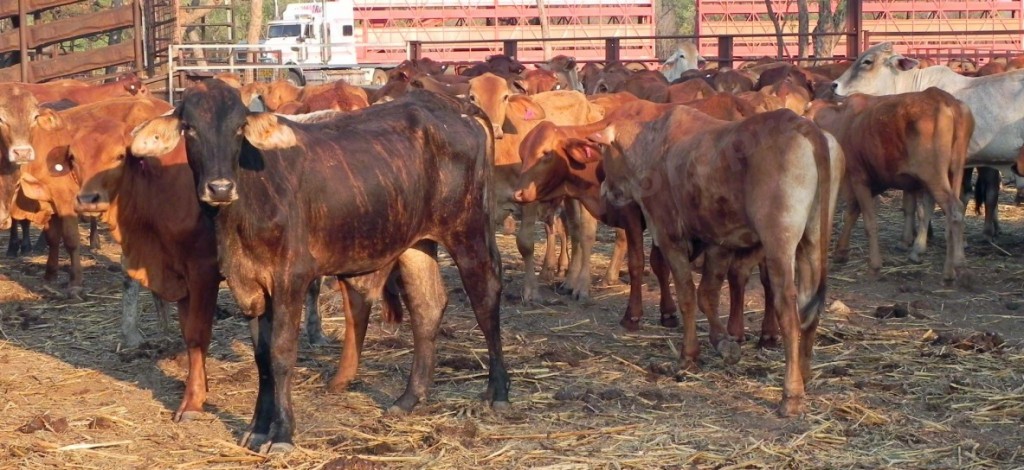 These steers averaged just over 220kg; they are approximately 1-2 years old. They were sold to another producer who had finishing country and was able to grow them out, still live export. Animals this age will attract premium prices per kg but as they are so light they don’t actually earn much in money to return costs.
These steers averaged just over 220kg; they are approximately 1-2 years old. They were sold to another producer who had finishing country and was able to grow them out, still live export. Animals this age will attract premium prices per kg but as they are so light they don’t actually earn much in money to return costs.
300kg – 350kg weights – Indonesia live animal export
 This animal is 2-3 years old, Brahman, grey, smooth coat, polled, and a steer. He is the ideal type for Indonesia. If we can grow this animal to as close to the 350kg weight as possible these are the most income efficient animals compared to their relative cost to produce for our business.
This animal is 2-3 years old, Brahman, grey, smooth coat, polled, and a steer. He is the ideal type for Indonesia. If we can grow this animal to as close to the 350kg weight as possible these are the most income efficient animals compared to their relative cost to produce for our business.
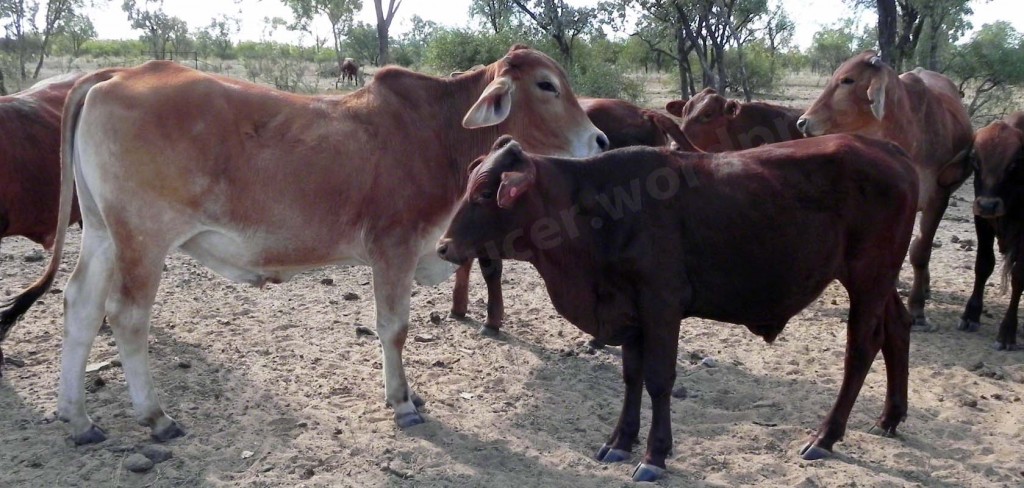 The lighter red to the left and the one at the top right looking to the side would be both suitable to Indonesia. They would be 2-3 years old. Compare their size to the red bloke in the front who is a year younger. We have had boat jobs reject the horns of the size on the guy at the right and the front red could possibly be ‘not exotic enough’ (high enough Brahman content to suit some export requirements even if he was to grow heavy enough next muster).
The lighter red to the left and the one at the top right looking to the side would be both suitable to Indonesia. They would be 2-3 years old. Compare their size to the red bloke in the front who is a year younger. We have had boat jobs reject the horns of the size on the guy at the right and the front red could possibly be ‘not exotic enough’ (high enough Brahman content to suit some export requirements even if he was to grow heavy enough next muster).
Over 350kg but less than 400kg
This is a really awkward weight range because Indonesian’s permits limit any individual animals to be less than 350kg, while other countries stipulate that the animal must be over 400kg. It is possible that the grey brahman in the first picture would actually fit this weight and possibly not be sent anywhere this year to sell.
In Australia we could put some in feedlots to background but the difficulty is that we would need to have a number to fill 6 decks in one hit to warrant the cost of freight and sale costs.
Over 400kg
In many ways the heavies as we call this group are extremely important markets in that they also take a lot of the cull animals that we only have small numbers of but do not wish to keep on property.
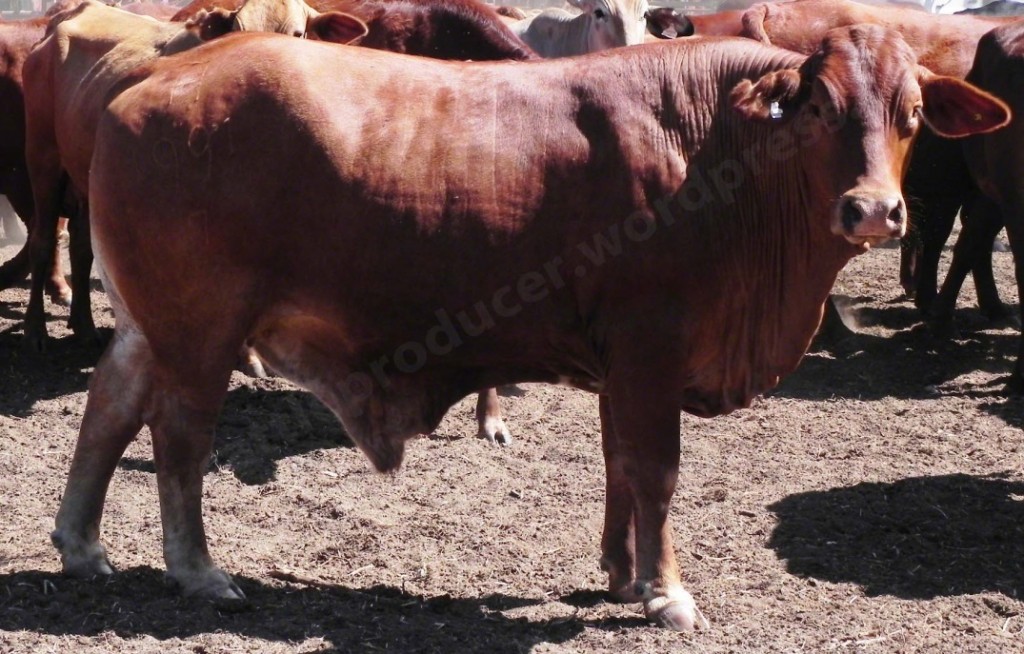 This bloke is over four years old, most probably five. He would have a full mouth and is actually suitable to slaughter in Australian abattoirs weight wise but wouldn’t receive premium prices due to indentation (the number of teeth he has which shows his age, younger animals receive better prices than older ones). To send to an abattoir he’d lose 10% body weight and need several weeks of rest and feed before slaughter at destination to be suitable to be slaughtered. This fella went to the Philippines; he was stunned and slaughtered on arrival.
This bloke is over four years old, most probably five. He would have a full mouth and is actually suitable to slaughter in Australian abattoirs weight wise but wouldn’t receive premium prices due to indentation (the number of teeth he has which shows his age, younger animals receive better prices than older ones). To send to an abattoir he’d lose 10% body weight and need several weeks of rest and feed before slaughter at destination to be suitable to be slaughtered. This fella went to the Philippines; he was stunned and slaughtered on arrival.
Animals over 400kg are good money earners due to weight but often receive substantial discount per kg once over the 400kg.
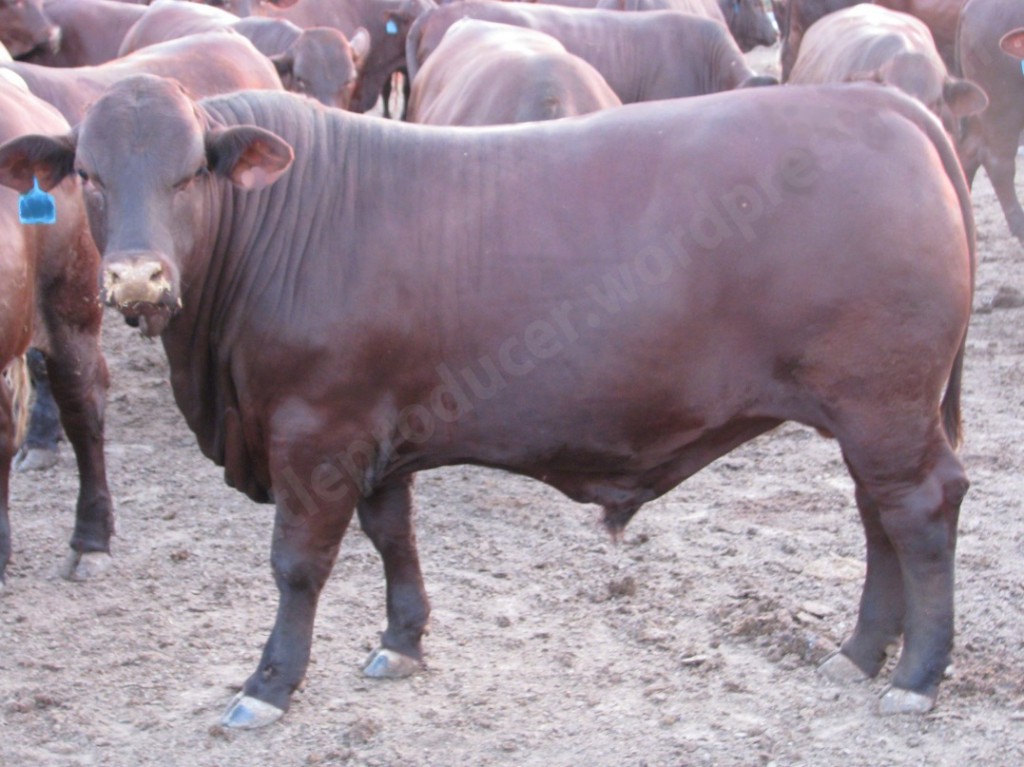 A friend has kindly allowed me to use this photo of a feedlot finished steer, he weighed in at 650kg, and he’s most likely milk to two tooth and less than two years old. This is the competition we would be up against. It is important to remember our animals due to phosphorus deficiency also have less bone density and often weigh lighter even though they look similar. Compare this to the less than two year old steer on our property two photos above.
A friend has kindly allowed me to use this photo of a feedlot finished steer, he weighed in at 650kg, and he’s most likely milk to two tooth and less than two years old. This is the competition we would be up against. It is important to remember our animals due to phosphorus deficiency also have less bone density and often weigh lighter even though they look similar. Compare this to the less than two year old steer on our property two photos above.
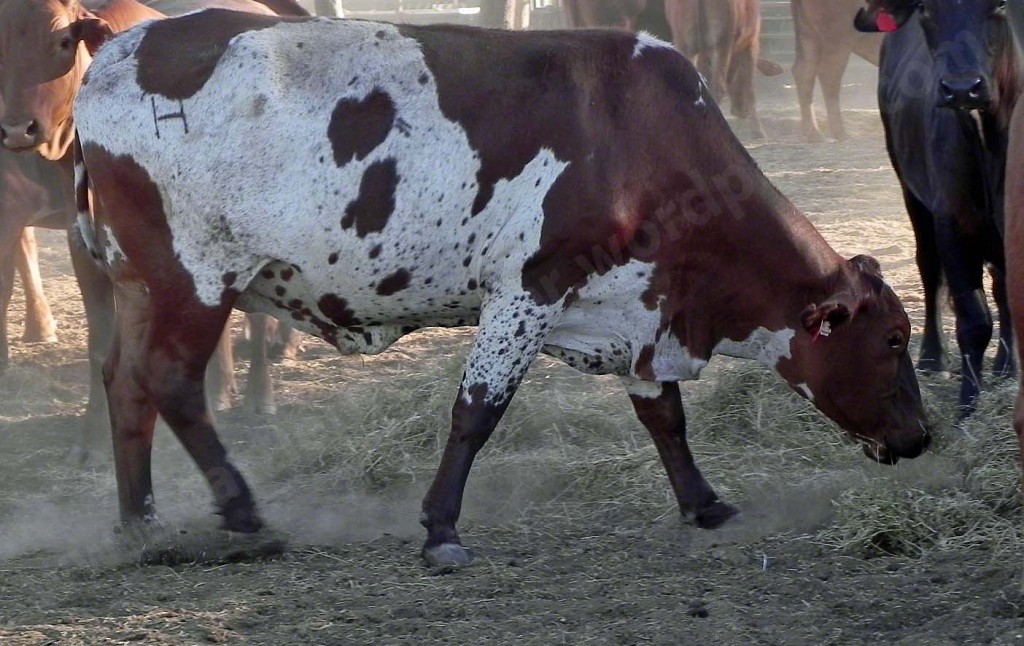 This is a dry cow; she hasn’t had a calf and is an unproductive animal. To be exported she would have been pregnancy tested. She also had to be over 400kg. She also went to the Philippines. Also stunned and slaughtered on arrival. Cows receive substantially less money per kg than steers. I don’t know why!
This is a dry cow; she hasn’t had a calf and is an unproductive animal. To be exported she would have been pregnancy tested. She also had to be over 400kg. She also went to the Philippines. Also stunned and slaughtered on arrival. Cows receive substantially less money per kg than steers. I don’t know why!
Dry cows are a substantial problem in the current market situations as they are costly to keep, yet not worth anything to sell. Many properties have spaying programs for unwanted cows and the cow is allowed to gain weight and sold when future opportunities arise.
Cull Bulls
 This is an ex herd bull, he’s old, and most likely lost his ‘mojo’ weighing close to 500kg. He also went to the Philippines. Money for bulls varies depending on what the festivals and happenings are in importing countries, their weight specifications can also be quiet low. Some countries prefer ‘entires’ (bulls) and are a valuable market for culls, rogues, and small bulls that we don’t wish to castrate.
This is an ex herd bull, he’s old, and most likely lost his ‘mojo’ weighing close to 500kg. He also went to the Philippines. Money for bulls varies depending on what the festivals and happenings are in importing countries, their weight specifications can also be quiet low. Some countries prefer ‘entires’ (bulls) and are a valuable market for culls, rogues, and small bulls that we don’t wish to castrate.
I would like to thank Jane Sale and Steph Coombes for allowing me to participate with the ‘Central Station’ blog, I hope you have enjoyed reading the last few days and I know I am really looking forward to the many varied and diverse blogs to come. Best of luck everyone and thank-you for taking the time to read my writings.
